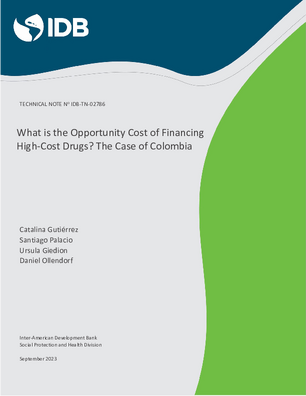What is the Opportunity Cost of Financing High-Cost Drugs? The Case of Colombia
Date
Sep 2023
We find ourselves in a fortunate yet challenging situation: we have access to more beneficial health technologies than we can afford to finance. However, this increased availability, coupled with an ageing population and epidemiological changes, is straining health spending worldwide. To ensure that higher spending actually maximizes benefits, it is crucial for this growth to be sustainable, to not divert resources from other important investments and to be in line with the goals of the health system. Given limited resources, allocating funds to one technology means forgoing allocation to others. Like many Latin American countries, Colombia grapples with the financial burden of covering high-cost drugssome of which are highly-effective, while others show reduced clinical effectiveness. Each of these drugs carries an opportunity cost in terms of the health gains lost by allocating these resources elsewhere.
To achieve this, we analyzed ten drugs selected based on their significant budgetary impact or high cost per case. These drugs were oncologic, for autoimmune and orphan diseases, and one for diabetes. In Colombia, financing these drugs instead of the best available alternatives results in an additional cost of US$453 million for the duration of treatments for all current recipients. The quality adjusted life years (QALY) provided by these technologies average (per patient and for the duration of the treatments) is less than a year of perfect health (0.73 QALY). Alternatively, if these resources were redirected to expand and enhance existing health system services, the net gain would amount to 88,000 life years in perfect health.
In other words, defunding certain services to finance the ten selected high-cost drugs would result in Colombians losing 88,000 life years of perfect health. In this article, we aim to quantify the opportunity cost of financing high-cost drugs in Colombia.
To achieve this, we analyzed ten drugs selected based on their significant budgetary impact or high cost per case. These drugs were oncologic, for autoimmune and orphan diseases, and one for diabetes. In Colombia, financing these drugs instead of the best available alternatives results in an additional cost of US$453 million for the duration of treatments for all current recipients. The quality adjusted life years (QALY) provided by these technologies average (per patient and for the duration of the treatments) is less than a year of perfect health (0.73 QALY). Alternatively, if these resources were redirected to expand and enhance existing health system services, the net gain would amount to 88,000 life years in perfect health.
In other words, defunding certain services to finance the ten selected high-cost drugs would result in Colombians losing 88,000 life years of perfect health. In this article, we aim to quantify the opportunity cost of financing high-cost drugs in Colombia.




